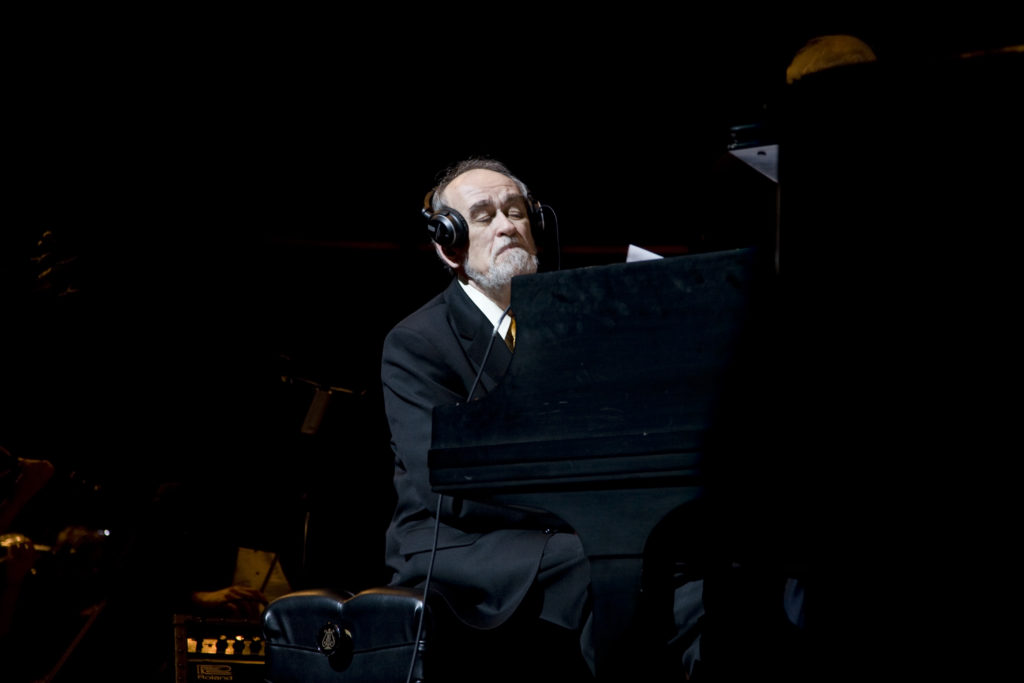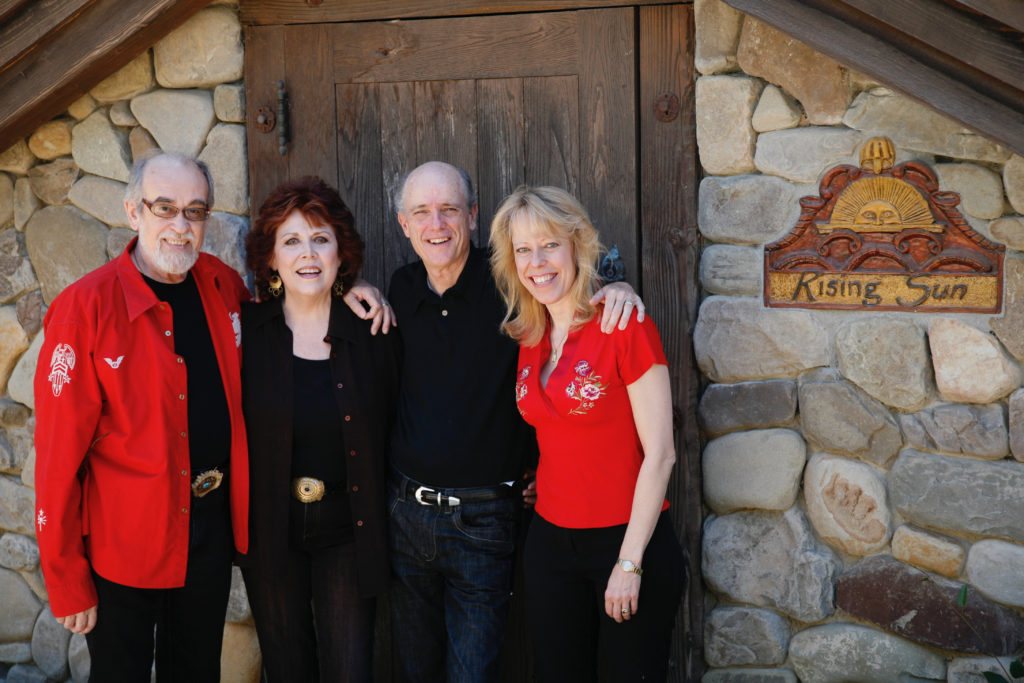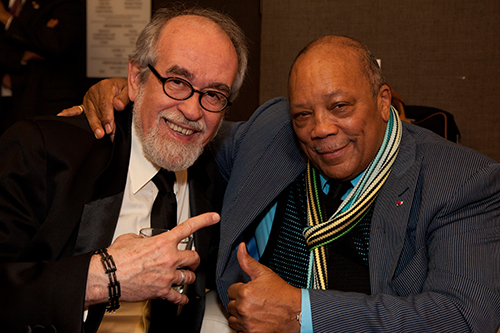FEATURES | By Mark Lewis
All That Jazz

Roger Kellaway at work, photo by Logan Hall.
As his 80th birthday looms, legendary Ojai pianist-composer Roger Kellaway looks back on his storied 65-year career, during which he boldly straddled musical genres while collaborating with world-class artists.
Protean and prolific: These adjectives attached themselves to jazzman Roger Kellaway in New York way back in the early ‘60s, and they still apply today. As a player, arranger or composer, he has worked on more than 250 record albums over the years, more than 30 of which have his own name on the cover, and he won a Grammy along the way. An Oscar-nominated film composer, he has scored 27 films, orchestrated them, and conducted the orchestra. (He has worked on other films as a player, orchestrator or conductor.) As a live performer, he has appeared with the biggest names in jazz, some of the biggest in pop, and several famous classical-music virtuosos.
Kellaway turns 80 on Nov. 1, and the prospect of that milestone has put him in the mood for taking stock. What follows are Roger’s ruminations on his remarkable and ongoing career, which began at the age of 15 when he got his American Federation of Musicians union card as a high school student. We will interpolate comments published in years past by the late jazz writer Gene Lees of Ojai, Kellaway’s good friend and sometime collaborator.
Pianos were common in American parlors in the 1940s, and there was one in the Kellaway home in Waban, Mass., a suburb of Boston. But young Roger didn’t play it – not until the day in 1946 when his father sat down to play “The Bells of St. Mary’s,” a sentimental chestnut that had recently been appropriated by Hollywood for a hit movie of the same title starring Bing Crosby. Roger’s father was a painting contractor, not a musician, but what he played that day struck a chord with his 7-year-old son. After listening to his father’s rendition, Roger seated himself at the upright and improvised his own version.
“They asked me if I wanted to take lessons,” Kellaway says. “And I said, ‘yes.’ So, at 7, I started doing classical studies.”
By the age of 12, he already knew that he would make music his career. But, which kind of music? Hearing the jazz pianist George Shearing’s hit “I’ll Remember April” already had prompted Kellaway to expand his horizons beyond Bach and Beethoven.
“I was crossing over into jazz through George Shearing,” he says.
Kellaway did not entirely cross over – he retained a foot in both camps. At Newton High School, he played bass in the school orchestra and also in his friend Dick Sudhalter’s Dixieland jazz combo, which played local dances. Meanwhile, he continued to study classical music with his piano teacher, and he also was listening to contemporary jazz artists – especially his idol, the pianist Oscar Peterson.
“Roger in those days was an omnivore, open to everything,” Sudhalter later told Gene Lees. “The older styles interested him as much as the new stuff. … His capacity for absorption was limitless.”
Kellaway says he enjoyed the challenge of mastering different musical genres.
“When I was very young, going in 10 directions at once felt very natural to me,” he says. “Sound is the major common denominator. It’s sound that attracts me.”
His high-school years were the heyday of Elvis Presley, Buddy Holly and Chuck Berry, but Kellaway gravitated more toward the beatnik milieu, where young men sported goatees and jazz was king. Rock mostly left him cold.
“I was never touched by it,” he says. “Not deeply.”
After graduating from Newton in 1957, Kellaway spent about two years studying piano, bass and composition at the New England Conservatory of Music in nearby Boston, while also gigging with his own jazz quintet. As a member of the conservatory chorus, he performed with the Boston Symphony Orchestra, but then he pivoted back to jazz and hit the road as a bass player for the Dixieland-style cornetist Jimmy McPartland. That six-month tour was followed by another, with a different jazz band. Somewhere along the way, Roger met and married his first wife, the singer Patty Hale. By 1960 they had quit the road and settled in New York. (He and Patty later divorced.)
Most young musicians struggle to find work when they first arrive in the Big Apple. Not Roger Kellaway.
“My first night in New York,” he says, “I sat in with Jimmy Giuffre and Jim Hall, on bass.”
Soon, Kellaway was a regular at the many 52nd Street jazz clubs; at midtown joints such as Birdland and Jilly’s Saloon; and at the Half Note near Greenwich Village. Nevertheless, his days as a bass man were numbered. He decided to focus on the piano instead, and soon was in great demand as a sideman and session player with the likes of jazz greats Clark Terry and Bob Brookmeyer.
“By the age of 22, he was one of the busiest and most highly respected pianists in New York, playing record dates, jazz clubs, and working with singers such as Lena Horne,” Lees wrote in a profile of Kellaway. (The two men met in 1961, when Kellaway was the pianist on the recording of a song for which Lees had written the lyric.)
During this period, Roger played on three albums that remain among his personal career highlights: ”More Blues and the Abstract Truth” by Oliver Nelson; “Bumpin’ ” by Wes Montgomery; and ”Alfie” by Sonny Rollins. But Kellaway was more than just a sideman, or a session player for hire. He was also writing and performing his own material. In 1963 he released his first album, “A Jazz Portrait of Roger Kellaway.” Two years later, he released a follow-up, “The Roger Kellaway Trio,” which earned a ringing endorsement from no less than Time Magazine: “A gem for piano lovers of all persuasions by one of the most versatile creators around.”
Note the use of the word “versatile.” Jazz writers would repeatedly apply it to Kellaway over the years, along with “eclectic,” “multi-faceted,” “protean” and “a musical chameleon.”
“Roger Kellaway, a jazz pianist whose interests range from old-fashioned, two-fisted swing to electronic experimentation, ran through a large portion of his gamut,” John S. Wilson wrote in the New York Times in early 1966, reviewing a recent club appearance. Kellaway “played with a rollicking joy that gave his performance an intensely rhythmic feel even when he was working in a relatively slow tempo.”

Roger and Jorjana Kellaway with Visions of America collaborator Joe Sohm and his wife Leslie.
By this point, Roger was playing a duo in his private life with Jorjana McIntosh, a stunning showgirl from California.
“She was a Playboy bunny in the New York Playboy Club,” Roger says. “Someone called her and asked her if she would work the party room on Nov. 11, 1965, and she said, ‘Who’s playing the piano?’ ”
Monty Alexander, they told her.
“And she loved Monty Alexander, so she said yes. But Monty couldn’t make the gig, so he’d asked me to substitute for him.”
The rest is history. They married in June 1966, and they’re still married today. (Roger helped Jorjana raise her son from a previous marriage, Colin Kellaway.)
The newlywed Kellaways migrated west, where Roger found himself fielding more job offers from pop-music singers. In August 1966, he played the Flamingo Hotel in Las Vegas as musical director for the singer Bobby Darin. (An up-and-coming young comic named Richard Pryor was their opening act.)
The gig as Darin’s director lasted for more than two years, and it wasn’t limited to live dates – Roger played on Darin’s single “If I Were a Carpenter,” a Top 10 hit in 1967, and arranged and orchestrated his “Bobby Darin Sings Dr. Dootlittle” album the same year. But he also was doing his own thing in L.A. with the Roger Kellaway Quartet, a jazz outfit that included a young sax player named Tom Scott, who was featured on the quartet’s 1967 album “Spirit Feel.”
“He is one of the greatest eclectics of modern piano,” L.A. Times jazz critic Leonard Feather wrote in 1968. Kellaway was prone to experiment, Feather wrote, but did not push these experiments too far: “In a sense, he is the Oscar Peterson of the younger set, for no matter how advanced his stylistic concepts, he rarely fails to swing.”
Kellaway launched his film-composer career in 1968 by scoring, arranging and conducting the music for “Paper Lion,” starring Alan Alda. The following year, he played piano on the soundtrack for “Change of Habit,” Elvis Presley’s last movie as an actor.
“I spent a day with him at Universal doing the soundtrack,” Kellaway recalls of Presley. “What a nice guy.”
From Elvis, the ever-eclectic Kellaway segued to George Balanchine, the presiding genius of the New York City Ballet, who commissioned Roger to compose a ballet based on a Pan American Airways television commercial. Balanchine supplied the choreography, and Kellaway got to conduct one of the performances at Lincoln Center. During the same period, roughly 1969-70, he wrote and recorded “Remembering You,” the piano instrumental closing theme for the enormously popular TV series “All In The Family.” The honkytonk style Kellaway adopted for this recording also served him well on one he did for the singer Melanie — “Brand New Key,” which shot up to No. 1 on the Billboard Hot 100 chart at the end of 1971, and stayed there for three weeks.
But there was nothing honkytonk about “The Roger Kellaway Cello Quartet,” also released in 1971, on Herb Alpert’s A&M Records. Despite the title, there was only one cello in the group, played by the classical-music virtuoso Edgar Lustgarten. The quartet’s other three members, including pianist Kellaway, were jazzmen. This disc represents a highly original synthesis of jazz and classical music. They sometimes are described as the beginning of “New Age” music, although Kellaway prefers the term “crossover.”
The Cello Quartet album is what first brought Kellaway to Ojai. The quartet performed at the Ojai Music Festival in 1973 at the invitation of Michael Tilson Thomas, who was that year’s musical director.
“He was a Cello Quartet fan,” Kellaway explains.
The Cello Quartet albums may have impressed Tilson Thomas, but they failed to sell well, and Gene Lees knew why.
“Roger Kellaway suffers from the curse of unclassifiability,” Lees wrote in the New York Times in 1975. “He is a brilliant and colorful jazz pianist, but his mind is as much in classical music as it is in jazz. … Commercially, the albums have suffered, as much of Kellaway’s work has, from failure to fit a pigeonhole. Are they classical music? Jazz? Popular music? They have elements of all three, and in the end, who cares? They’re intriguing simply as music.”
Meanwhile, Kellaway had shifted gears yet again, joining forces with Tom Scott’s jazz-fusion group The L.A. Express, which had backed Joni Mitchell on her hit album “Court and Spark.” Kellaway did not play on that 1974 record, but he and guitarist Robben Ford joined the band for the subsequent tour – 55 concerts, all of them played before crowds far larger than a jazzman like Kellaway was used to. Ever adaptable, he began playing to the crowd, rock-star style:
“When I was onstage with Joni Mitchell and there were 10,000 people in the audience, I thought they were mine.”
The tour brought him to England, where one night George Harrison invited the band to jam in the ex-Beatle’s home studio. Two songs they recorded that night, “Hari’s On Tour (Express)” and “Simply Shady,” were the opening tracks on Harrison’s next album, “Dark Horse,” with Kellaway on piano and organ.
After the Joni Mitchell tour ended, Kellaway produced a well-received album, “I Am Music,” for the jazz singer Carmen McCrae, then went on to write the score for the 1976 version of “A Star Is Born,” starring Barbra Streisand.
The score earned Kellaway an Oscar nomination, so he donned a tuxedo and attended the ceremony at the Dorothy Chandler Pavilion, only to lose the Oscar to the composer of the Woody Guthrie biopic “Bound for Glory.”
Interestingly, the Oscar nomination did not necessarily make Kellaway an A-list film composer; nor did “I Am Music” make him an A-list record producer; nor did the Joni Mitchell tour make him the go-to guy for rock stars looking for a keyboard player. He wouldn’t stay put in any category long enough to be identified with it.
“It may well be contended that Kellaway has too many talents for his own good,” Leonard Feather observed in 1977.
In 1983, Roger and Jorjana moved back to New York. The next decade brought him bounteous professional opportunities, of which we can only skim some of the highlights: He played Jerusalem with Dizzy Gillespie in 1985; served as musical director in 1988 for Stephane Grappelli’s 80th birthday tribute at Carnegie Hall, with Roger writing jazz lines for classical cellist Yo-Yo Ma; won a “best instrumental arrangement” Grammy award for a suite on the 1988 album “Memos From Paradise,” by jazz clarinetist Eddie Daniels; and wrote “Songs of Ascent,” a classical piece for tuba and symphony orchestra commissioned by the New York Philharmonic, and conducted at Lincoln Center in 1989 by Zubin Mehta.
Roger and Jorjana returned to California in 1993 and landed in Ojai. Their friends Robben and Anne Kerry Ford had just moved here; their friends Gene and Janet Lees already lived here; and Roger, despite his many decades in New York and L.A., was favorably disposed toward small-town living.
“Since I grew up in a small town, Ojai was very comfortable for me,” he says. “I like going into stores and having people call me by my name.”
They rented for a year, then bought a house off Villanova Road with a lovely “pink moment” view of the Topa Topa Ridge. The walls feature paintings by Jorjana’s father, Robert McIntosh, a noted artist who once worked as an illustrator on “Fantasia” and other Disney classics. There’s also a home recording studio featuring a 7-foot-6-inch-long grand piano made especially for Roger by the Bluthner firm in Leipzig, Germany.
Gene Lees welcomed Roger to town by writing a two-part analysis of his career in the Jazzletter, Lees’s idiosyncratic, “must read” jazz newsletter.
“No one … has suffered as much from the propensity to pigeonhole art and artists as Roger Kellaway,” Lees wrote. “Kellaway has all his life refused to be placed in categories. And to make things harder on himself, he often mixes the idioms.”
Lees quoted an exchange he once had with Oscar Peterson about Kellaway:
“I love Roger Kellaway!” Peterson said. “He knows the tradition, and he’s not afraid.”
Meaning that Kellaway, who started out playing Dixieland and modern jazz at the same time, was well grounded in the legacy sounds, but eager to go beyond them.
“Being diversified has made my life extremely interesting, but difficult for people who are trying to market me, for they keep looking for the ultimate category I’m in, and I’m not in one,” Roger told Gene, as quoted in the Jazzletter.
The world increasingly prefers to deal with “a compartmentalized mind,” Roger said. “And that’s not where I’m at.”
Twenty-five years later, Kellaway still eschews compartmentalization. What he enjoys is hearing something new, and then working out how it was done. It all goes back to what he felt as a 7-year-old, listening to his father play “The Bells of St. Mary’s,” and feeling impelled to try it himself.
“There’s a basic curiosity,” he says. “Like, ‘Wow, what’s that?’ ”
Since he settled in Ojai, Kellaway’s career has continued apace. Some highlights over the years include “Both Sides Now,” a 2004 album with the violinist Yue Deng, a Gene Lees protégé; “Heroes,” a 2006 Roger Kellaway Trio tribute to Oscar Peterson’s famous late 1950s trio (this record won the Prix du Jazz Classique from the French Jazz Academy); a 2007 concert tour with Tony Bennett; “Invictus,” the 2009 film by Clint Eastwood, a longtime fan of Kellaway’s jazz albums, for whom Roger orchestrated the film’s score and conducted the orchestra; and Kellaway’s and Eddie Daniels’ 2013 live album “Duke at the Roadhouse,” a tribute to Duke Ellington which won the French Academy’s Grand Prix.
There was also “Visions of America,” a multi-media collaboration with the noted Ojai photographer Joseph Sohm and the lyricists Marilyn and Alan Bergman, with Eastwood as the narrator. The music part of this ambitious “photo-symphony” project combines singers, a full orchestra, and Kellaway himself on jazz piano.
As he contemplates the prospect of turning 80, Kellaway does not see himself taking on any more major composing projects like “Visions.” His writing process requires too much mental isolation, too much alone time, and at this point in his life, he wants to spend that time with Jorjana.
“You get a lot more mortal in your thinking,” he says. “You don’t know how much time you’ve got left.”
But he’ll still be writing songs, doing arrangements, making albums, and performing in front of audiences. He will celebrate his Nov. 1 birthday with a series of gigs, including one with his old friend Tom Scott in Palm Springs on Oct. 27; two at Birdland in New York on Nov. 15-16; and one back in L.A. at Vitello’s in Studio City on Nov. 29. See his website, rogerkellaway.com, for details. And while you’re there, browse the site’s archives and wonder at the vastness and variety of Kellaway’s musical output over the years, regarding which this article has barely scratched the surface.
“How lucky I’ve been to work with some of the greatest musicians in the history of jazz,” he says.
As for his unusual versatility, Kellaway says he’s just built that way.
“Each of our lives can be compared to a wheel,” he says. “I just happen to have more spokes.” ≈OQ≈


Leave A Comment